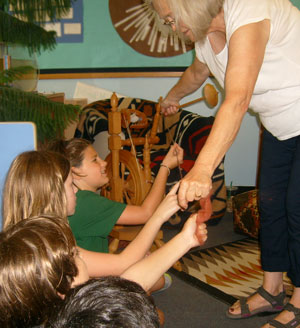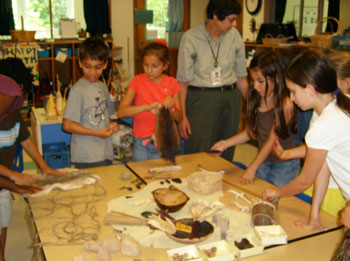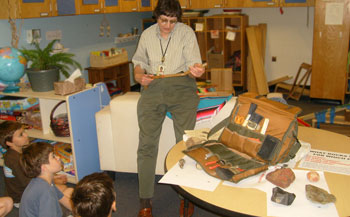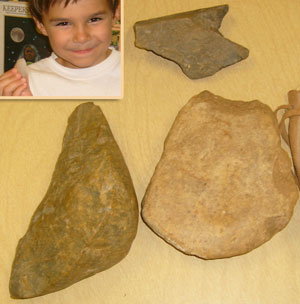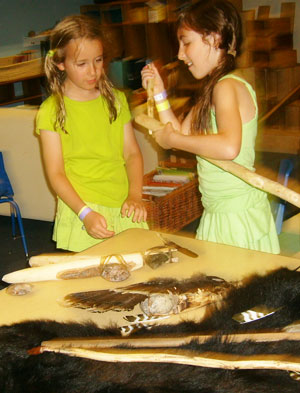

| Home | Week 1 | Week 2 | Week 3 | Week 4 | Week 5 | Week 6 |
|---|---|---|---|---|---|---|
Week 4
You could call this "Speaker Week". We were lucky enough to schedule five separate speakers! To learn more scroll on......
Monday Ms. Jennings, a spinner, came to explain to the children how the Navajo tribe from the Southwest learned to weave blankets and rugs during the contact period. She brought in a print of a Navajo weaver, a Navajo rug and her spindle and spinning wheel. I liked the spinner because it was fun feeling the rabbit fur and watching her spin. I learned that the Europeans invented the peddle for the spinning wheel and the Asian Indians invented the spinning wheel. The Navajos traded for the spinning wheel. Ian I found out that you cannot spin dog hair because it doesn't have barbs on it to help it attach to other hairs like sheep's wool does and that it smells like a wet dog when it's wet. Caitlin The Native Americans used nuts and all kinds of things to dye the wool. Danielle |
|
Carol Ebright an Archeologist working for the State Highway Department brought in a trunk full of Maryland Woodland Indian artifacts. She discussed what her job entailed and we found out she has to do a lot of reports! The Archeologist brought spears and toys and skins. Ian When Archeologist find something they have to fill out a lot of forms to show the exact spot they found it so they can use that information later. Risa I learned that an Archeologist is sort of like a Paleontologist that works with dinosaur bones, but they work with indian and other human artifacts. Jacob I learned that if you find an artifact its not good to sell it because it might be pretty rare. Ian Indians used a scraper to scrap off the goo from the hides they tan. Neel I found out the oldest stuff is on the bottom and the youngest stuff is on the top. The middle stuff is in the middle. Tess Some Indians used parts of bones to make games. We got to play a stick and deer bone game .Gabrielle Read some of our stories entitled "If I were an Archeologist....."
|
|
Tuesday Mr Newman, a CYC parent, came and showed us some of his artifact collection from this area. I learned that the Indians hit rocks against other rocks to make weapons and tools. Alex It takes a very long time to make a weapon because they have to hit the rocks. Josh I thought it was cool how they used the rocks to cut down trees and do other things. At first I thought they were just rocks. Maryclaire I found out that it is not that easy to find artifacts. You have to go to places like the creek we went to and look. When we went to the creek I think I found a bone. Neel |
|
Can you see where we are? The CSPAC pond was so overgrown that we found it difficult to find an area to get to the water! Some of us did manage to catch a few Rosey Red Minnows to bring back for our classroom aquarium. We also brought back some cattails. The Native Americans used cattails for food, medicine and weaving. Check out the Native Tech web site for more information. |
|
ThursdayOne of our Dads, brought in some artifacts he had found in the Washington area. His enthusiasm was contagious. He also brought two Native American flutes and his bow and arrow. Everyone enjoyed trying to pull the bow string. Surprisingly, even though it was a 40 pound bow, the Blueberries were able to pull it back quite far. Our Dad also shared some artwork he had done of Indian Chiefs. He generously made enough copies to share with everyone including the teachers! My Dad was looking for some Indian stuff and he couldn't find any of them, he kept walking and walking all day and just when he was about to give up, he found an arrowhead and he said, "Huh that looks like an arrowhead" and he picked it up and said, "Oh my that is an arrowhead!". So he put it with his collection and we were planning one day he could come into my class, the Blueberries, and show his Indian artifacts. That is his story. |
|
FridayMr. Wiest, a Primitive Technologist, brought in an "Early Indian Toolkit" filled with tools he had made and a slide show showing how the Indians lived after the last Ice-age. Mr. Wiest showed the evolution of the spear from a basic stick with a stone spear point, to one with a removable point, to the atlatl, a tool that fits into the spear and gives the hunter more leverage when it is thrown. He also had a soapstone bowl he had carved, a bark quiver case and a partial bear hide he had tanned. I liked Mr. Wiest's stuff. I liked the bear fur, the ears were so soft, I thought all animals ears were the softest place on their body and it was true of the bear. the roughest place was the nose. The other fur was OK, a little rough and a little soft. Tess The hammer was interesting to me. Danielle I think my favorite part was a tool that looked like a tool you would throw up in a mountain and it would help you climb because it would stick into the ground. Mr. Wiest said it was a tool for digging. |
|
